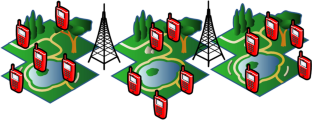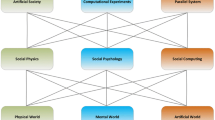Abstract
Cognitive radio is an intelligent communication system that is aware of its environment and can dynamically adapt its operating parameters with the aim of providing an efficient use of the scarce spectrum. The main advantage of cognitive radio technology is its ability to adapt and cooperate with all other wireless technologies such as fifth generation technology, 5G. 5G enabled cognitive radio technology provides accelerated communication performance in accordance with spectrum efficiency and energy efficiency. 5G enabled cognitive radio proposes system interoperability and integration of communication system through cognition. Social networking is a common communication media among internet users connected by one or more relationships. Large numbers of internet users share their experiences and thoughts through social networking web sites. Semantic analysis is defined as the process of drawing meaning from text. In this paper, a fuzzy logic based semantic analysis is performed for the estimation of comment content in 5G enabled cognitive radio based social networks. In social networks, the positive comments posted by the users have the positive influence for the members to examine related comments. The comment content posted by the users is decided to be positive or negative with the help of fuzzy logic based semantic analysis approach. In this regard, the relevant interpretation can be positive or negative based on the input parameters in the fuzzy logic system. Our 5G enabled cognitive radio technology based semantic analysis approach with fuzzy logic system can be utilized in many social networks, taking superior accuracy results of 93% into account.







Similar content being viewed by others
References
Huang, Y., Zhao, P., Zhang, Q., Xing, L., Wu, H., & Ma, H. (2023). A Semantic-enhancement-based social network user-alignment algorithm. Entropy, 25(1), 172. https://doi.org/10.3390/e25010172
Liu, X., Zhang, Y., Yejun, Xu., Li, M., & Herrera-Viedma, E. (2023). A consensus model for group decision-making with personalized individual self-confidence and trust semantics: A perspective on dynamic social network interactions. Information Sciences, 627, 147–168. https://doi.org/10.1016/j.ins.2023.01.087
Ramakrishna, M. T., et al. (2023). HCoF: Hybrid collaborative filtering using social and semantic suggestions for friend recommendation. Electronics, 12(6), 1365. https://doi.org/10.3390/electronics12061365
Li, H., Song, J. B., Chen, C.-F., Lai, L., & Qiu, R. C. (2014). Behavior propagation in cognitive radio networks: A social network approach. IEEE Transactions on Wireless Communications, 13(2), 646–657. https://doi.org/10.1109/TW.2013.121813.121964
Deng, Y., Gou, F., & Wu, J. (2021). Hybrid data transmission scheme based on source node centrality and community reconstruction in opportunistic social networks. Peer-to-Peer Networking and Applications, 14, 3460–3472. https://doi.org/10.1007/s12083-021-01205-3
Zhang, X., et al. (2021). Effective communication data transmission based on community clustering in opportunistic social networks in IoT system. Journal of Intelligent & Fuzzy Systems, 41(1), 2129–2144.
Xiaokaiti, A., Qian, Y., & Wu, J. (2021). Efficient data transmission for community detection algorithm based on node similarity in opportunistic social networks. Complexity, 2021, 9928771, 18 p. https://doi.org/10.1155/2021/9928771
Huang, Z., Li, X., & Wu, J. (2022). An effective data transmission scheme based on IoT system in opportunistic social networks. International Journal of Communication Systems, 35(4), e5062. https://doi.org/10.1002/dac.5062
Lu, Y., Chang, L., Luo, J., & Wu, J. (2021). Routing algorithm based on user adaptive data transmission scheme in opportunistic social networks. Electronics, 10(10), 1138. https://doi.org/10.3390/electronics10101138
Chen, S., Chen, Z., Wu, J., & Liu, K. (2020). An adaptive delay-tolerant routing algorithm for data transmission in opportunistic social networks. Electronics, 9(11), 1915. https://doi.org/10.3390/electronics9111915
Li, X., & Wu, J. (2020). Node-oriented secure data transmission algorithm based on IoT system in social networks. IEEE Communications Letters, 24(12), 2898–2902. https://doi.org/10.1109/LCOMM.2020.3017889
Xiao, Y., & Wu, J. (2020). Data transmission and management based on node communication in opportunistic social networks. Symmetry., 12(8), 1288. https://doi.org/10.3390/sym12081288
Yan, Y., Chen, Z., Wu, J., Wang, L., Liu, K., & Wu, Y. (2019). Effective data transmission strategy based on node socialization in opportunistic social networks. IEEE Access, 7, 22144–22160. https://doi.org/10.1109/ACCESS.2019.2898895
Wu, J., Chen, Z., & Zhao, M. (2020). An efficient data packet iteration and transmission algorithm in opportunistic social networks. Journal of Ambient Intelligence and Humanized Computing, 11, 3141–3153. https://doi.org/10.1007/s12652-019-01480-2
Yan, Y., Chen, Z., Wu, J., & Wang, L. (2018). An effective data transmission algorithm based on social relationships in opportunistic mobile social networks. Algorithms, 11(8), 125. https://doi.org/10.3390/a11080125
Wu, J., Zou, W., & Long, H. (2021). Effective path prediction and data transmission in opportunistic social networks. IET Communications, 15, 2202–2211. https://doi.org/10.1049/cmu2.12254
Khalaf, O. I., Ogudo, K. A., & Singh, M. (2021). A fuzzy-based optimization technique for the energy and spectrum efficiencies trade-off in cognitive radio-enabled 5G network. Symmetry, 13(1), 47. https://doi.org/10.3390/sym13010047
Mavromoustakis, C. X., Bourdena, A., Mastorakis, G., et al. (2015). An energy-aware scheme for efficient spectrum utilization in a 5G mobile cognitive radio network architecture. Telecommunication Systems, 59, 63–75. https://doi.org/10.1007/s11235-014-9885-4
Zhang, W., Wang, C.-X., Ge, X., & Chen, Y. (2018). Enhanced 5G cognitive radio networks based on spectrum sharing and spectrum aggregation. IEEE Transactions on Communications, 66(12), 6304–6316. https://doi.org/10.1109/TCOMM.2018.2863385
Li, A., & Han, G. (2018). A fairness-based MAC protocol for 5G Cognitive Radio Ad Hoc Networks. Journal of Network and Computer Applications, 111, 28–34. ISSN 1084–8045, https://doi.org/10.1016/j.jnca.2018.03.019
Hu, F., Chen, B., & Zhu, K. (2018). Full spectrum sharing in cognitive radio networks toward 5G: A survey. IEEE Access, 6, 15754–15776. https://doi.org/10.1109/ACCESS.2018.2802450
Ahmad, W. S. H. M. W., et al. (2020). 5G technology: Towards dynamic spectrum sharing using cognitive radio networks. IEEE Access, 8, 14460–14488. https://doi.org/10.1109/ACCESS.2020.2966271
Silva, A. L. C., et al. (2023). Prescriptive and semantic analysis of an automatic sign language translation: Cases on VLibras Avatar translation using video interviews and textual interactions with a Chatbot. Interacting with Computers, 35(2), 231–246. https://doi.org/10.1093/iwc/iwac020
Laurini, R. (2022). Semantic analysis of feedforward knowledge for regional policymaking. In Laurini, R., Nijkamp, P., Kourtit, K., Bouzouina, L. (Eds.) Knowledge management for regional policymaking. Springer. https://doi.org/10.1007/978-3-031-15648-9_5
Chen, C.-M., Li, M.-C., & Huang, Y.-L. (2023). Developing an instant semantic analysis and feedback system to facilitate learning performance of online discussion. Interactive Learning Environments, 31(3), 1402–1420. https://doi.org/10.1080/10494820.2020.1839505
Funding
There is no funding to declare.
Author information
Authors and Affiliations
Contributions
S.B., wrote the main manuscript text; prepared figures. I.Y., contributed data or analysis tools; conceived and designed the analysis. All authors reviewed the manuscript.
Corresponding author
Ethics declarations
Competing Interests Statement
The authors have no competing interests.
Conflict of Interest
The authors declare that they have no conflict of interest.
Data Availability Statement
Enquiries about data availability should be directed to the authors.
Ethical Statement
The paper does not deal with any ethical problems.
Additional information
Publisher's Note
Springer Nature remains neutral with regard to jurisdictional claims in published maps and institutional affiliations.
Rights and permissions
Springer Nature or its licensor (e.g. a society or other partner) holds exclusive rights to this article under a publishing agreement with the author(s) or other rightsholder(s); author self-archiving of the accepted manuscript version of this article is solely governed by the terms of such publishing agreement and applicable law.
About this article
Cite this article
Bayrakdar, S., Yucedag, I. Exploiting 5G Enabled Cognitive Radio Technology for Semantic Analysis in Social Networks. Wireless Pers Commun 133, 1585–1598 (2023). https://doi.org/10.1007/s11277-023-10829-y
Accepted:
Published:
Issue Date:
DOI: https://doi.org/10.1007/s11277-023-10829-y




